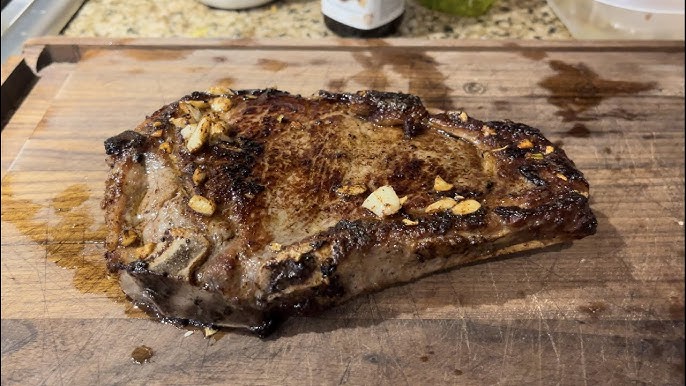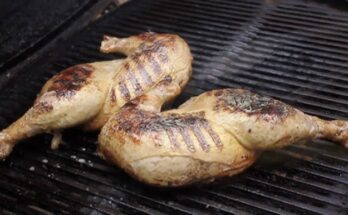T-Bone Steak Recipe: The T-bone steak, known for its iconic “T”-shaped bone and the mouthwatering combination of tenderloin and strip steak, is a legendary cut that promises flavor and satisfaction. Whether you’re a backyard BBQ enthusiast or a home cook trying to master steak night, the T-bone delivers both taste and texture like few other cuts can. It’s a steakhouse favorite for a reason, and once you learn to cook it right, you’ll never look back.
The beauty of the T-bone lies in its dual personality—on one side of the bone, you’ve got the filet mignon (super tender), and on the other, the strip steak (rich in flavor). This gives you the best of both worlds in one piece of meat. If you’re new to cooking steaks, the T-bone is a great place to start because its thickness makes it more forgiving. You’re less likely to overcook it as long as you keep a close eye.
And let’s not forget the flair—serving a sizzling, grill-marked T-bone steak right off the heat is guaranteed to impress anyone at your table.
Choosing the Right T-Bone Steak
Before you fire up the grill or heat your cast-iron skillet, selecting the right cut is crucial. Not all T-bones are created equal, and the difference often lies in the quality and thickness.
Here’s what to look for:
- Marbling: Look for visible fat streaks running through the meat. More marbling means more flavor and juiciness.
- Thickness: A good T-bone steak should be at least 1 to 1.5 inches thick. Thinner cuts are more prone to overcooking.
- Color: Fresh T-bone steaks have a bright red color. Avoid anything that looks brown or dull.
- Bone Size: The “T” should be prominent. This not only makes it visually impressive but also contributes to even cooking.
If possible, opt for USDA Prime or Choice grades, as these have better marbling and flavor. Talk to your butcher and don’t be afraid to ask questions. They can cut it fresh and even provide tips.
Bone-In vs. Boneless: T-bone steaks are traditionally bone-in, and that’s part of the charm. The bone helps retain moisture and adds depth of flavor during cooking. Go for bone-in whenever possible unless you’re working with specific dietary restrictions.
Ingredients You’ll Need
Making a great T-bone steak doesn’t require a laundry list of ingredients. In fact, simplicity is the key to letting the meat shine. Here’s what you’ll need:
Core Ingredients:
- 1 T-bone steak (1–1.5 inches thick)
- Kosher salt
- Freshly ground black pepper
- Olive oil or vegetable oil
Optional Additions:
- Garlic cloves (crushed)
- Fresh rosemary or thyme
- Butter (for basting)
- Steak seasoning or spice rub
- Lemon juice or balsamic vinegar (for post-cooking drizzle)
While salt and pepper are the foundation, feel free to get creative with rubs or herbs. A garlic-thyme butter baste adds a beautiful layer of flavor, and a touch of lemon juice can help cut through the richness.
The most important thing? Don’t over-season. The T-bone’s flavor should be front and center, not hidden under too many spices.
Preparing the Steak
Prepping your steak is where the magic starts. This step ensures your steak cooks evenly and tastes phenomenal.
Step 1: Bring to Room Temperature
Let your T-bone sit out for 30–45 minutes before cooking. This allows the muscle fibers to relax and ensures more even cooking. Cooking a cold steak can result in a raw center and overcooked edges.
Step 2: Season Generously
Pat the steak dry with paper towels. Moisture on the surface can steam the meat instead of searing it. Season both sides liberally with salt and pepper. The salt helps create that mouth-watering crust.
Step 3: Optional Marination
If you prefer a flavored crust, rub the steak with crushed garlic, herbs, or a bit of spice blend and let it rest in the fridge for a couple of hours. This step isn’t mandatory but can add depth.
Pro Tip: Avoid adding acidic ingredients (like vinegar or lemon) before cooking—they can break down the meat and make it mushy. Save them for after.
Cooking Tools You’ll Need
Your tools matter almost as much as your technique. You don’t need a fancy setup, but a few key items can make all the difference.
Grill vs. Skillet:
- Grill: Offers smoky flavor and beautiful char lines. Best for outdoor cooking.
- Cast Iron Skillet: Great for indoor cooking. It retains heat well and creates an incredible sear.
Essentials:
- Tongs (not forks—don’t pierce the meat!)
- Meat thermometer (to check internal temperature)
- Aluminum foil (for resting)
- Timer or phone stopwatch (to track cook times)
A cast iron skillet is your best bet if you’re cooking indoors. It allows for high heat, even cooking, and caramelizes the meat perfectly.
Step-by-Step Cooking Instructions
Now comes the part where it all comes together—cooking your T-bone to sizzling perfection. Whether you’re using a grill or skillet, the goal is to create a delicious sear on the outside while keeping the inside juicy and tender.
Step 1: Preheat Your Grill or Skillet
Preheating is non-negotiable. You need your grill or skillet extremely hot before the steak hits the surface. This high heat is what gives the T-bone its signature crust.
- Grill: Heat one side to high and leave the other side cooler for indirect cooking. This helps you manage thicker cuts.
- Skillet: Let your cast iron skillet sit over medium-high heat for at least 5 minutes. Add a splash of oil just before the steak goes in.
A properly preheated surface ensures a Maillard reaction—science-speak for that beautiful brown sear we all love.
Step 2: Sear the Steak
Place the steak down and listen for the sizzle—that’s how you know it’s hot enough.
- Grill: Sear each side for 2–3 minutes directly over the flame.
- Skillet: Sear each side for about 3–4 minutes, pressing down slightly for full contact.
Once you’ve got a golden-brown crust, move the steak to indirect heat (on the grill) or lower the heat (on the stove) to finish cooking without burning the outside.
Step 3: Finishing Touches
Add flavor boosters like butter, crushed garlic, and fresh herbs. Baste the steak by tilting the skillet and spooning the melted butter over the top for 1–2 minutes. This adds richness and makes your kitchen smell amazing.
Use a meat thermometer to check the internal temperature (more on that in the next section). Once your T-bone hits the right temp, remove it immediately and get ready to rest.
Doneness Guide
Cooking your T-bone steak to the perfect level of doneness is what separates amateurs from pros. Here’s a simple guide to help you hit the sweet spot.
| Doneness | Internal Temp (°F) | Characteristics |
|---|---|---|
| Rare | 120–125°F | Cool, red center |
| Medium Rare | 130–135°F | Warm, red center |
| Medium | 140–145°F | Warm, pink center |
| Medium Well | 150–155°F | Slightly pink center |
| Well Done | 160°F and up | Little or no pink |
Use an instant-read thermometer and insert it into the thickest part of the meat, away from the bone. Don’t rely on guesswork—especially with a premium cut like a T-bone.
Pro Tip: Remove the steak from heat when it’s 5°F below your desired temp. It will continue to cook while resting (this is called carryover cooking).
Resting the Steak
You’ve cooked the steak—now the hardest part: letting it rest. Don’t skip this step.
After pulling your T-bone off the heat, transfer it to a plate or cutting board and tent loosely with foil. Let it sit for at least 5 to 10 minutes.
Why Rest?
- It allows juices to redistribute throughout the meat.
- Cutting too early results in dry steak and a pool of wasted flavor on your plate.
Resist the urge to dig in. Give it a few minutes, and your patience will be rewarded with a more flavorful, juicy bite.
Serving Suggestions
Now for the fun part—what to serve with your perfectly cooked T-bone. This steak is rich and hearty, so lighter sides or bold contrasts work best.
Side Dish Ideas:
- Garlic mashed potatoes – classic and creamy.
- Grilled asparagus or green beans – a fresh, crisp contrast.
- Caesar salad – cool and crunchy.
- Mac and cheese – for when you want to go all out.
- Corn on the cob – adds sweetness and summer vibes.
Sauce Suggestions:
- Chimichurri
- Garlic herb butter
- Béarnaise or peppercorn sauce
- Balsamic glaze
Serve the T-bone whole or slice it across the grain for easier sharing. Add a lemon wedge or drizzle of olive oil for that extra wow factor.
Tips for the Perfect T-Bone Every Time
Even with a solid recipe, getting that steakhouse-quality T-bone every single time takes practice—and a few inside tricks. Here are some essential tips to help you master it:
1. Let the Steak Sit Before Cooking
Don’t rush it from the fridge to the grill. Letting it sit at room temperature for about 30–45 minutes ensures even cooking. This reduces the risk of having a raw center and burnt edges.
2. Use High Heat for Searing
Whether you’re on the grill or using a cast iron skillet, high heat is a must for that crispy, flavorful crust. Without it, your steak can turn out gray and flavorless. Remember: color equals flavor!
3. Don’t Overcrowd the Pan or Grill
Cooking more than one steak? Make sure there’s space around each one. Crowding leads to steaming instead of searing, and no one wants that.
4. Only Flip Once
Resist the urge to constantly turn your steak. One good flip is all you need. This helps form that perfect crust and keeps the inside juicy.
5. Let It Rest
This point is worth repeating. Resting the steak allows the juices to settle back into the meat. Slice too soon, and you lose all that flavorful moisture.
6. Use a Meat Thermometer
Guesswork is not your friend here. A thermometer gives you precise control, so you never have to suffer through an overcooked (or undercooked) steak again.
7. Season Well
Salt and pepper are your best friends. Don’t be shy—season from a height to ensure even coverage and use coarse salt for a better crust.
8. Butter Baste for Richness
This adds a glossy finish and extra flavor. A little butter, garlic, and fresh thyme or rosemary in the final minutes of cooking can turn a good steak into a gourmet one.
Avoid common mistakes like pressing the steak down while cooking (you’ll lose juices), over-flipping, or skipping the rest. Follow these tips and you’ll get better results every time.
Variations to Try
Ready to mix things up? The classic T-bone is amazing on its own, but if you’re feeling adventurous, try these creative twists to take it to the next level:
1. Spice Blends and Rubs
Instead of the usual salt and pepper, experiment with different dry rubs:
- Cajun spice for a southern kick
- Montreal steak seasoning for bold flavor
- Coffee rub for a rich, smoky edge
Apply your rub a few hours before cooking and let it sit in the fridge. This helps infuse the flavor into the meat.
2. Marinades
Want to tenderize and flavor your T-bone at the same time? Try a marinade. Here are a few ideas:
- Balsamic and rosemary – Sweet and earthy
- Soy, garlic, and ginger – For an Asian-inspired twist
- Red wine and herbs – Classic and aromatic
Marinate for at least 2 hours, but no more than 12. Too long, and the acid can break down the meat too much.
3. Alternative Cooking Methods
- Oven Finish: Start in a skillet and then transfer to the oven to finish cooking evenly.
- Reverse Sear: Cook slowly at a low temp (oven or grill), then finish with a high-heat sear.
- Sous Vide: Precision cooking in a water bath gives you perfect doneness, followed by a quick sear for texture.
These methods offer more control and are great for thick cuts where getting the perfect center is tricky.
Tired of the same old steak routine? Try these variations and turn your next meal into a culinary adventure.
Nutritional Info
Wondering what’s in your T-bone steak? Here’s a general breakdown of the nutritional value for an average 16 oz (about 450g) cooked T-bone steak:
| Nutrient | Amount |
|---|---|
| Calories | 960–1,200 |
| Protein | 80–90g |
| Fat | 65–85g |
| Saturated Fat | 25–35g |
| Cholesterol | 250–300mg |
| Sodium | 150–300mg |
| Iron | 20–25% DV |
| Vitamin B12 | 100%+ DV |
T-bone steak is packed with protein and essential vitamins like B12 and iron. It’s perfect for low-carb diets like keto or paleo. However, because it’s high in saturated fats and cholesterol, moderation is key.
Want to lighten it up? Trim visible fat and pair it with veggie-based sides like grilled zucchini or roasted Brussels sprouts. And always opt for leaner cuts if you’re watching your heart health.
FAQs about T-Bone Steak Recipe
1. Can I cook a T-bone steak in the oven only?
Yes! Use the reverse sear method: start in a low oven (around 275°F) until it’s close to your desired temp, then sear it in a hot skillet for a crispy crust.
2. How long should I cook a T-bone steak?
It depends on thickness and desired doneness. A 1.5-inch steak typically takes 10–14 minutes total. Always use a thermometer for accuracy.
3. Should I marinate my T-bone steak?
Not necessary, but you can. Marinades add flavor but aren’t essential if you’re using a high-quality cut and good seasoning.
4. Can I freeze T-bone steak?
Absolutely. Wrap it tightly in plastic and foil, and it can last up to 6 months in the freezer. Thaw slowly in the fridge before cooking.
5. What’s the difference between a T-bone and a porterhouse?
Both have a “T” bone, but the porterhouse has a larger tenderloin section. They’re cut from different parts of the short loin.
Final Thoughts
Cooking a T-bone steak at home might seem intimidating, but once you’ve done it right, it’ll become your go-to special meal. From picking the right cut to mastering the sear and resting period, it’s all about the details. With a little patience and the right techniques, you’ll get restaurant-quality results right from your own kitchen.
A T-bone steak is more than just food—it’s an experience. The sizzle, the aroma, the tender bite—it’s satisfaction in every mouthful. So the next time you’re looking to impress or simply treat yourself, you know what to cook.
Fire up that grill (or skillet), grab a thick cut, and get cooking. Your perfect T-bone steak is waiting.



